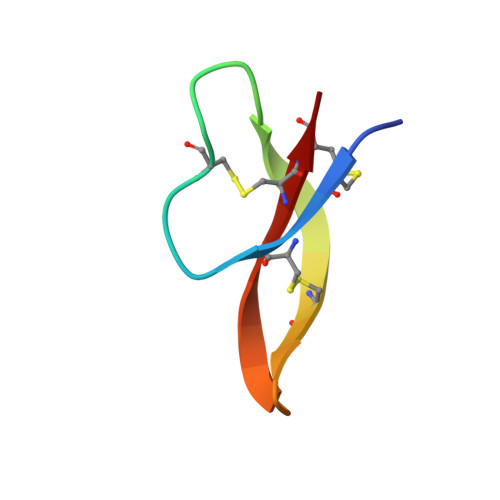Human Enteric alpha-Defensin 5 Promotes Shigella Infection by Enhancing Bacterial Adhesion and Invasion.
Xu, D., Liao, C., Zhang, B., Tolbert, W.D., He, W., Dai, Z., Zhang, W., Yuan, W., Pazgier, M., Liu, J., Yu, J., Sansonetti, P.J., Bevins, C.L., Shao, Y., Lu, W.(2018) Immunity
- PubMed: 29858013
- DOI: https://doi.org/10.1016/j.immuni.2018.04.014
- Primary Citation of Related Structures:
5CUI, 5CUJ, 5CUM - PubMed Abstract:
Shigella is a Gram-negative bacterium that causes bacillary dysentery worldwide. It invades the intestinal epithelium to elicit intense inflammation and tissue damage, yet the underlying mechanisms of its host selectivity and low infectious inoculum remain perplexing. Here, we report that Shigella co-opts human α-defensin 5 (HD5), a host defense peptide important for intestinal homeostasis and innate immunity, to enhance its adhesion to and invasion of mucosal tissues. HD5 promoted Shigella infection in vitro in a structure-dependent manner. Shigella, commonly devoid of an effective host-adhesion apparatus, preferentially targeted HD5 to augment its ability to colonize the intestinal epithelium through interactions with multiple bacterial membrane proteins. HD5 exacerbated infectivity and Shigella-induced pathology in a culture of human colorectal tissues and three animal models. Our findings illuminate how Shigella exploits innate immunity by turning HD5 into a virulence factor for infection, unveiling a mechanism of action for this highly proficient human pathogen.
Organizational Affiliation:
Key Laboratory of Biomedical Information Engineering of the Ministry of Education, School of Life Science and Technology, Xi'an Jiaotong University, Xi'an, China; Center for Translational Medicine, Frontier Institute of Science and Technology, Xi'an Jiaotong University, Xi'an, China; Institute of Human Virology and Department of Biochemistry and Molecular Biology, University of Maryland School of Medicine, Baltimore, MD, USA.

















